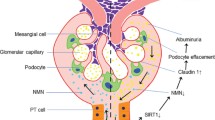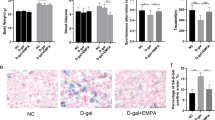Abstract
Caloric restriction prolongs the lifespan of many species. Therefore, investigators have researched the usefulness of caloric restriction for healthy lifespan extension. Sirt1, an NAD+-dependent deacetylase, was identified as a molecule necessary for caloric restriction-related anti-aging strategies. Sirt1 functions as an intracellular energy sensor to detect the concentration of NAD+, and controls in vivo metabolic changes under caloric restriction and starvation through its deacetylase activity to many targets including histones, nuclear transcriptional factors, and enzymes. During the past decade, investigators have reported the relationship between disturbance of Sirt1 activation and the onset of aging- and obesity-associated diseases such as diabetes, cardiovascular disease and neurodegenerative disorders. Consequently, a calorie restriction-mimetic action of Sirt1 is now expected as a new therapy for these diseases. In addition, recent studies have gradually clarified the role of Sirt1 in the onset of kidney disease. Its activation may also become a new target of treatment in the patients with chronic kidney disease including diabetic nephropathy. In this article, we would like to review the role of Sirt1 in the onset of kidney disease based on previous studies, and discuss its possibility as the target of treatment in diabetic nephropathy.


Similar content being viewed by others
References
Brenner, B.M., M.E. Cooper, D. De Zeeuw, W.F. Keane, W.E. Mitch, H.H. Parving, G. Remuzzi, S.M. Snapinn, Z. Zhang, and S. Shahinfar. 2001. Effects of losartan on renal and cardiovascular outcomes in patients with type 2 diabetes and nephropathy. New England Journal of Medicine 345: 861–869.
Brownlee, M. 2005. The pathobiology of diabetic complications: a unifying mechanism. Diabetes 54: 1615–1625.
Cherry, Engelman. 1998. R. W., Wang, B. Y., Kinjoh, K., El-Badri, N. S., and Good, R. A. Calorie restriction delays the crescentic glomerulonephritis of SCG/Kj mice. Proceedings of the Society for Experimental Biology and Medicine 218: 218–222.
Chuang, P.Y., Y. Dai, R. Liu, H. He, M. Kretzler, B. Jim, C.D. Cohen, and J.C. He. 2011. Alteration of forkhead box O (foxo4) acetylation mediates apoptosis of podocytes in diabetes mellitus. PLoS One 6: e23566.
Cohen, H.Y., C. Miller, K.J. Bitterman, N.R. Wall, B. Hekking, B. Kessler, K.T. Howitz, M. Gorospe, R. De Cabo, and D.A. Sinclair. 2004. Calorie restriction promotes mammalian cell survival by inducing the SIRT1 deacetylase. Science 305: 390–392.
Colman, R.J., R.M. Anderson, S.C. Johnson, E.K. Kastman, K.J. Kosmatka, T.M. Beasley, D.B. Allison, C. Cruzen, H.A. Simmons, J.W. Kemnitz, and R. Weindruch. 2009. Caloric restriction delays disease onset and mortality in rhesus monkeys. Science 325: 201–204.
DCCT Research Group. 1993. The effect of intensive treatment of diabetes on the development and progression of long-term complications in insulin-dependent diabetes mellitus. The Diabetes Control and Complications Trial Research Group. The New England Journal of Medicine 329: 977–986.
Dioum, E.M., R. Chen, M.S. Alexander, Q. Zhang, R.T. Hogg, R.D. Gerard, and J.A. Garcia. 2009. Regulation of hypoxia-inducible factor 2alpha signaling by the stress-responsive deacetylase sirtuin 1. Science 324: 1289–1293.
Fan, Y.Y., M. Kohno, H. Hitomi, K. Kitada, Y. Fujisawa, J. Yatabe, M. Yatabe, R.A. Felder, H. Ohsaki, K. Rafiq, S.J. Sherajee, T. Noma, A. Nishiyama, and D. Nakano. 2011. Aldosterone/Mineralocorticoid receptor stimulation induces cellular senescence in the kidney. Endocrinology 152: 680–688.
Fontana, L., L. Partridge, and V.D. Longo. 2010. Extending healthy life span–from yeast to humans. Science 328: 321–326.
Hasegawa, K., S. Wakino, K. Yoshioka, S. Tatematsu, Y. Hara, H. Minakuchi, K. Sueyasu, N. Washida, H. Tokuyama, M. Tzukerman, K. Skorecki, K. Hayashi, and H. Itoh. 2010. Kidney-specific overexpression of Sirt1 protects against acute kidney injury by retaining peroxisome function. Journal of Biological Chemistry 285: 13045–13056.
Hasegawa, K., S. Wakino, K. Yoshioka, S. Tatematsu, Y. Hara, H. Minakuchi, N. Washida, H. Tokuyama, K. Hayashi, and H. Itoh. 2008. Sirt1 protects against oxidative stress-induced renal tubular cell apoptosis by the bidirectional regulation of catalase expression. Biochemical and Biophysical Research Communications 372: 51–56.
He, W., Y. Wang, M.Z. Zhang, L. You, L.S. Davis, H. Fan, H.C. Yang, A.B. Fogo, R. Zent, R.C. Harris, M.D. Breyer, and C.M. Hao. 2010. Sirt1 activation protects the mouse renal medulla from oxidative injury. The Journal of Clinical Investigation 120: 1056–1068.
Hwang, I., J. Lee, J.Y. Huh, J. Park, H.B. Lee, Y.S. Ho, and H. Ha. 2012. Catalase deficiency accelerates diabetic renal injury through peroxisomal dysfunction. Diabetes 61: 728–738.
Kitada, M., A. Takeda, T. Nagai, H. Ito, K. Kanasaki, and D. Koya. 2011. Dietary restriction ameliorates diabetic nephropathy through anti-inflammatory effects and regulation of the autophagy via restoration of Sirt1 in diabetic Wistar fatty (fa/fa) rats: a model of type 2 diabetes. Experimental Diabetes Research 2011: 908185.
Koya, D., and G.L. King. 1998. Protein kinase C activation and the development of diabetic complications. Diabetes 47: 859–866.
Kume, S., M. Haneda, K. Kanasaki, T. Sugimoto, S. Araki, M. Isono, K. Isshiki, T. Uzu, A. Kashiwagi, and D. Koya. 2006. Silent information regulator 2 (SIRT1) attenuates oxidative stress-induced mesangial cell apoptosis via p53 deacetylation. Free Radical Biology and Medicine 40: 2175–2182.
Kume, S., M. Haneda, K. Kanasaki, T. Sugimoto, S. Araki, K. Isshiki, M. Isono, T. Uzu, L. Guarente, A. Kashiwagi, and D. Koya. 2007. SIRT1 inhibits transforming growth factor beta-induced apoptosis in glomerular mesangial cells via Smad7 deacetylation. Journal of Biological Chemistry 282: 151–158.
Kume, S., T. Uzu, K. Horiike, M. Chin-Kanasaki, K. Isshiki, S. Araki, T. Sugimoto, M. Haneda, A. Kashiwagi, and D. Koya. 2010. Calorie restriction enhances cell adaptation to hypoxia through Sirt1-dependent mitochondrial autophagy in mouse aged kidney. The Journal of Clinical Investigation 120: 1043–1055.
Li, J., X. Qu, S.D. Ricardo, J.F. Bertram, and D.J. Nikolic-Paterson. 2010. Resveratrol inhibits renal fibrosis in the obstructed kidney: potential role in deacetylation of Smad3. American Journal of Pathology 177: 1065–1071.
Liang, F., S. Kume, and D. Koya. 2009. SIRT1 and insulin resistance. Nature Reviews Endocrinology 5: 367–373.
Lin, S.J., P.A. Defossez, and L. Guarente. 2000. Requirement of NAD and SIR2 for life-span extension by calorie restriction in Saccharomyces cerevisiae. Science 289: 2126–2128.
McCay, C.M., and M.F. Crowell. 1934. Prolonging the life span. The Scientific Monthly 39: 405–414.
Maeda, S., D. Koya, S. Araki, T. Babazono, T. Umezono, M. Toyoda, K. Kawai, M. Imanishi, T. Uzu, D. Suzuki, H. Maegawa, A. Kashiwagi, Y. Iwamoto, and Y. Nakamura. 2011. Association between single nucleotide polymorphisms within genes encoding sirtuin families and diabetic nephropathy in Japanese subjects with type 2 diabetes. Clinical and Experimental Nephrology 15: 381–390.
Mattagajasingh, I., C.S. Kim, A. Naqvi, T. Yamamori, T.A. Hoffman, S.B. Jung, J. Dericco, K. Kasuno, and K. Irani. 2007. SIRT1 promotes endothelium-dependent vascular relaxation by activating endothelial nitric oxide synthase. Proceedings of the National Academy of Sciences USA 104: 14855–14860.
Mckiernan, S.H., V.C. Tuen, K. Baldwin, J. Wanagat, A. Djamali, and J.M. Aiken. 2007. Adult-onset calorie restriction delays the accumulation of mitochondrial enzyme abnormalities in aging rat kidney tubular epithelial cells. American Journal of Physiology - Renal Physiology 292: F1751–F1760.
Mimura, I., and M. Nangaku. 2010. The suffocating kidney: tubulointerstitial hypoxia in end-stage renal disease. Nature Reviews Nephrology 6: 667–678.
Miyazaki, R., T. Ichiki, T. Hashimoto, K. Inanaga, I. Imayama, J. Sadoshima, and K. Sunagawa. 2008. SIRT1, a longevity gene, downregulates angiotensin II type 1 receptor expression in vascular smooth muscle cells. Arteriosclerosis, Thrombosis, and Vascular Biology 28: 1263–1269.
Nisoli, E., C. Tonello, A. Cardile, V. Cozzi, R. Bracale, L. Tedesco, S. Falcone, A. Valerio, O. Cantoni, E. Clementi, S. Moncada, and M.O. Carruba. 2005. Calorie restriction promotes mitochondrial biogenesis by inducing the expression of eNOS. Science 310: 314–317.
Ohkubo, Y., H. Kishikawa, E. Araki, T. Miyata, S. Isami, S. Motoyoshi, Y. Kojima, N. Furuyoshi, and M. Shichiri. 1995. Intensive insulin therapy prevents the progression of diabetic microvascular complications in Japanese patients with non-insulin-dependent diabetes mellitus: a randomized prospective 6-year study. Diabetes Research and Clinical Practice 28: 103–117.
Shikata, K. 2007. Microinflammation in the pathogenesis of diabetic nephropathy. Nippon Jinzo Gakkai Shi 49: 474–480.
Tikoo, K., K. Singh, D. Kabra, V. Sharma, and A. Gaikwad. 2008. Change in histone H3 phosphorylation, MAP kinase p38, SIR 2 and p53 expression by resveratrol in preventing streptozotocin induced type I diabetic nephropathy. Free Radical Research 42: 397–404.
UKPDS Group. 1998. Intensive blood-glucose control with sulphonylureas or insulin compared with conventional treatment and risk of complications in patients with type 2 diabetes (UKPDS 33). UK Prospective Diabetes Study (UKPDS) Group. Lancet 352: 837–853.
Uzu, T., G. Kimura, A. Yamauchi, M. Kanasaki, K. Isshiki, S. Araki, T. Sugiomoto, Y. Nishio, H. Maegawa, D. Koya, M. Haneda, and A. Kashiwagi. 2006. Enhanced sodium sensitivity and disturbed circadian rhythm of blood pressure in essential hypertension. Journal of Hypertension 24: 1627–1632.
Yeung, F., J.E. Hoberg, C.S. Ramsey, M.D. Keller, D.R. Jones, R.A. Frye, and M.W. Mayo. 2004. Modulation of NF-kappaB-dependent transcription and cell survival by the SIRT1 deacetylase. EMBO Journal 23: 2369–2380.
Yoshizaki, T., S. Schenk, T. Imamura, J.L. Babendure, N. Sonoda, E.J. Bae, D.Y. Oh, M. Lu, J.C. Milne, C. Westphal, G. Bandyopadhyay, and J.M. Olefsky. 2010. SIRT1 inhibits inflammatory pathways in macrophages and modulates insulin sensitivity. American Journal of Physiology - Endocrinology and Metabolism 298: E419–E428.
Zhang, D., S. Li, P. Cruz, and B.C. Kone. 2009. Sirtuin 1 functionally and physically interacts with disruptor of telomeric silencing-1 to regulate alpha-ENaC transcription in collecting duct. Journal of Biological Chemistry 284: 20917–20926.
Zhuo, L., B. Fu, X. Bai, B. Zhang, L. Wu, J. Cui, S. Cui, R. Wei, X. Chen, and G. Cai. 2011. NAD Blocks High Glucose Induced Mesangial Hypertrophy via Activation of the Sirtuins-AMPK-mTOR Pathway. Cellular Physiology and Biochemistry 27: 681–690.
Acknowledgments
JSPS KAKENHI (00452235 to S.K.), the Uehara Memorial Foundation (to S.K.), Takeda Science Foundation (to S.K.) and Banyu Life Science Foundation International (to S.K.), The 4th Annual Research Award Grant of Japanese Society of Anti-Aging Medicine (to D.K.), Grant for Collaborative Research from Kanazawa Medical University (C2011-4, C2012-1) and Grant for Specially Promoted Research from Kanazawa Medical University (SR2012-06).
Conflict of interest
All the authors declare no conflict of interests regarding this manuscript.
Author information
Authors and Affiliations
Corresponding author
Rights and permissions
About this article
Cite this article
Kume, S., Kitada, M., Kanasaki, K. et al. Anti-aging molecule, Sirt1: a novel therapeutic target for diabetic nephropathy. Arch. Pharm. Res. 36, 230–236 (2013). https://doi.org/10.1007/s12272-013-0019-4
Received:
Accepted:
Published:
Issue Date:
DOI: https://doi.org/10.1007/s12272-013-0019-4




